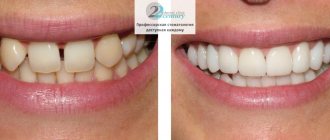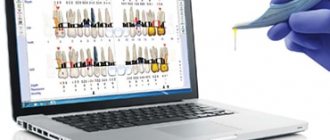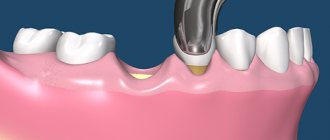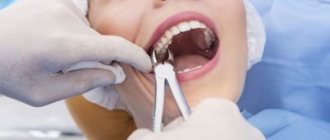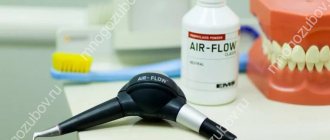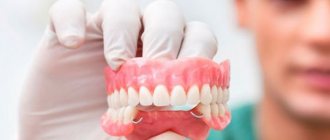Why are teeth bad?
Everyone has friends who are concerned about the health of their teeth, but at the same time do not get out of the dentist's chair, while others forget to brush them and are not familiar with the drill.
Alas, healthy teeth are largely the result of genetics, which can sometimes make up for even insufficient care and poor nutrition. Although “a mouth full of teeth” is still more common among those who brush them twice a day, undergo professional cleaning every year, do not overindulge in sweets, and heal caries in a timely manner. After all, in a person who has bad teeth from birth, even a small hole in a couple of months can turn into a huge cavity that destroys the tooth beyond the possibility of restoration.
Click to enlarge
How do dental tissues develop in humans?
Anatomically, a human tooth consists of a crown, neck and root. The visible part of the tooth is surrounded by hard tissues - enamel, dentin and cement, which protect the soft tissue - pulp. It extends from the crown of the tooth to its roots, has a large number of vessels and nerve endings and is directly involved in the nutrition of the entire tooth. Unfortunately, all tooth tissues undergo age-related changes, so in this case we are dealing with complex aging.
Dental development begins in the prenatal period. Already in the second month, the fetus develops an oral cavity with a dental plate. The rudiments of baby teeth form on it. By the fourth month, clear cell differentiation occurs. We can find anameloblasts, which are responsible for the formation of enamel, and dentinoblasts, which form the basis for dentin. By the sixth month, the outer and inner layers of dentin with a network of tubules are formed, and the gradual formation of pulp occurs, in particular the formation of collagen fibers.
How an implant becomes yours
Although the implantation technique was developed back in the 1970-1980s, many put up with the absence of teeth, believing that implants are painful, expensive and unreliable. According to statistics, 96% of operated patients use the same implants for more than 25 years. They can be installed in 20–30 minutes and are no more painful than removal. Artificial teeth are not cheap, but long-term treatment of hopeless teeth is even more expensive. The problem is that between tooth extraction and installation of a crown on an implant, an average of 2–3 months passes. But for this period, temporary crowns can be made. The main advantage of implants is that they completely restore chewing function, preserve adjacent teeth, and do not develop caries.
Back to the past. Outdated methods of dental treatment that it’s time to forget about Read more
How to relieve your baby's condition
Many young parents are wondering how to relieve the unpleasant symptoms that accompany the “birth” of milk units. The simplest measure is to apply cold (a piece of ice) to the “working” gum. Dental gels or ointments can also come to the rescue, relieving pain, swelling, and stopping the inflammatory process. Important: any medications should be used only with the permission of a pediatrician (pediatric dentist).
Thus, pharmacies sell special gels with lidocaine and inert fillers (menthol, astringents, flavorings) intended for use exclusively during teething. Examples of such tools:
- Kalgel (contraindicated for diathesis).
- Dentinox.
- Kamistad.
- Holisal.
- Mundizal.
General recommendations for use: a small amount of the local drug should be applied to the “working gums” 3-4 times a day for no longer than 3 days in a row.
One day dentistry
Just a few years ago (and in some clinics even now), installing crowns took at least a month and required 4–6 visits to the dentist. Modern computer technologies make it possible to do this in 1–3 visits to the doctor. Dental impressions are becoming a thing of the past. Now, using an optical digital scanner, in 5-10 minutes the doctor receives a digitized image of the dentition, which is sent to a machine - a Triumfus multi-axis processing center (the latest development of the military-industrial complex together with dentists), on which the crown is machined automatically in 14-16 minutes. The machine can produce 200 crowns per load. The development marked the beginning of a new industry - dental machine tools. Work on it can be carried out at night and on weekends without human intervention. Thanks to this, one-day dentistry arose.
Diagnosis of microdentia
According to statistics, about 5% of people face the problem of microdentia – abnormally small teeth in an adult. There are several signs that allow you to distinguish microdentia from other dental pathologies.
Symptoms of microdentia
- teeth of regular shape, but with a significantly reduced crown;
- distances between teeth visible to the naked eye;
- damage mainly to the front teeth;
- wavy or jagged shape of the cutting part of the affected tooth.
In most cases, the presence of microdentia can be determined by visual examination of the patient, but for a more accurate diagnosis, hardware diagnostics are performed. For example, the doctor can measure the overall width of the incisors of both jaws using a special instrument, as well as resort to x-rays. A deviation is considered to be a reduction of teeth by 1.5 mm or more relative to the norm. Based on the results of the examination, one of three types of microdentia is determined.
Isolated
If the patient has one or two small teeth, then we are talking about isolated microdentia. Most often, the front incisors (mainly the lateral incisors) are underdeveloped.
Relative
Relative microdentia is said to occur when the patient has an abnormally enlarged jaw. On such a jaw, even normal-sized crowns can look disproportionately small. Thus, relative microdentia is an overly large gum and small teeth on it.
Generalized
In the most severe cases, when small teeth are located throughout the jaw, the patient is diagnosed with “generalized microdentia.”
How are teeth related to the health of the whole body?
It is known that horses are chosen based on their teeth. Do people have strong teeth as an indicator of excellent health?
In Asia, there is a belief that teeth are a person’s karmic knots, and the loss of a tooth is associated with damage to karma. They believe that by healing a tooth, you can restore karma.
According to the Chinese method, each tooth is associated with a specific organ. This is partly confirmed by modern research. It has been established that there are 80 diseases that are based on a source of infection located in the teeth or gums. Once inside the body with the bloodstream, the infection can lead to the development of heart and vascular diseases, and bacteria living in dental plaque can cause pneumonia.
Traditional methods of “treating” teeth. The dentist analyzed 5 popular methods Read more
How do “eights” erupt?
It is impossible to give an unambiguous answer to the question of when wisdom teeth begin to grow and until what age do they grow. Third molars “come into the world” in the period from several months to 2-3 years, causing a lot of unpleasant sensations. When the “eights” begin to grow is influenced by many factors - in particular, the number of bone buds, heredity, and the anatomical features of the jaw (its shape). Due to the fact that third molars often create a certain discomfort - they affect the functioning of the TMJ, provoke sinusitis, and “displace” neighboring units of the dentition - they are often removed.
The main indications for extraction are:
- persistent hyperthermia (2–3 days) during the growth of wisdom teeth;
- acute inflammation of the gums (gingivitis) at the site of eruption;
- severe pain that makes eating difficult.
Anatomical features (shape) of the jaw, heredity and a number of other factors determine the timing of teething
Who are the enemies of implants?
Smoking reduces the lifespan of artificial teeth most significantly. Natural teeth are protected from tobacco aggression by the circular ligament and the mucous membrane attached to it, which acts as a barrier. Implants do not have such protection.
They also do not have periodontal tissue (the connective tissue surrounding the tooth), due to which their natural teeth feel pain when biting into hard food. You can bite through barbed wire with the implant without feeling any discomfort. Therefore, a person who has several implants in his mouth can periodically chew through bones, ribs, small pebbles that have fallen into food, etc. If this is done regularly, even the titanium from which they are made can collapse over time.
Growth of milk units
How to find out that your baby is getting his first teeth:
Viburkol for teething
- the gums become red, swell, a white ball can be visually identified, from which the milk unit will later “be born”;
- the child’s cheeks are burning;
- the baby becomes capricious, whiny, refuses to eat and sleeps poorly, and the body temperature may “jump” slightly.
Increased excitability is another “identifying sign” of the onset of teething. The child begins to put foreign objects into his mouth - chewing minimizes discomfort on the oral mucosa. A typical symptom is increased salivation - when the secretion gets on the skin of the face (in the cheeks, chin), it causes the appearance of foci of irritation (rash). Many parents notice limited hyperemic areas on the child’s neck (on the side where the tooth is cut).
Teething is a difficult period for a child’s body; against the background of restructuring and weakened immunity, children can be “attacked” by ARVI. So, if a child has attacks of nausea and vomiting, cough, abdominal pain, runny nose, appetite has disappeared or the body temperature has risen, it is recommended to immediately show him to a pediatrician.
After the appearance of the first milk units, young parents should take care of proper hygienic care for them
Important: you should not additionally stimulate (try to speed up) the process of eruption of baby teeth. Some parents scratch their gums with bread crust, a piece of sugar, and other irritants. Such measures will not have any effect on the “birth” of milk units, but they can provoke injuries to the oral mucosa or “contribute” to the development of a local inflammatory process.
No ads 3
Why do fillings fall out?
The filling, no matter what material it is made of, is not without drawbacks. Essentially, it is glue, which in different layers has a different structure and degree of condensation. Therefore, any temperature difference in the mouth causes a change in its volume. Because of this, microcracks occur, which eventually destroy the filling.
Today, when a tooth is destroyed, dentists prefer to use inlays (prostheses shaped like the missing part of the tooth). They are made on multi-axis specialized machines (on the same Triumfus) from a solid block of zirconium dioxide or lithium disilicate, which is 2 times stronger than tooth enamel (the strongest material in the body). This design can be installed even on a completely destroyed tooth, of which only one root remains (provided that there are no cracks, remnants of old pins or inflammation in it). Using modern digital methods, this can be done in the presence of the patient in 30–40 minutes.
Or maybe a filling would be better? Debunking myths about crowns Read more
Dangerous consequences of microdentia
At first glance, it seems that small teeth in an adult cause only aesthetic inconvenience, but this is not so. Dentists identify several quite serious problems that microdentia can lead to.
- Distal displacement of teeth,
that is, their gradual shift back relative to the optimal position in the jaw. - The appearance of gaps between the teeth
(the so-called diastemas and threes), which lead to disruption of the contact of the lateral surfaces of the teeth. Without support, the ligaments in the dental bed stretch and the tooth becomes unstable. - Diction disorders,
excessive amplification of hissing and whistling sounds in speech. - Periodontal disease
is a disease of the soft tissues of the jaw, caused by accumulations of bacteria in the interdental spaces and an enlarged periodontal pocket due to the high mobility of the tooth.
By the way
Is it possible to grow new ones?
Japanese scientists, using stem cells, grew the rudiments of permanent teeth in rats. Domestic researchers have patented a technology for obtaining stem cells from the tissues of baby teeth. After a baby tooth is removed, stem cells can be isolated from it, frozen, and later used to grow a new tooth. While this technology is just being developed, it is possible that in the future doctors will be able to grow teeth to replace those that have fallen out right in the patient’s mouth.
Until what age do human teeth grow?
Baby teeth begin to erupt before one year of age. As a rule, at 2-2.5 years a child receives a full set of baby teeth. The molars are located immediately behind the milk teeth: between them there is a partition that is destroyed during the eruption of permanent teeth. The change of teeth in a person begins at the age of 6-7 years: the upper incisors usually fall out first. The milk bite is replaced by a permanent one at about 12-13 years of age. Molars develop more slowly than baby teeth, and the roots of wisdom teeth can continue to form up to 23 years of age and even later.
